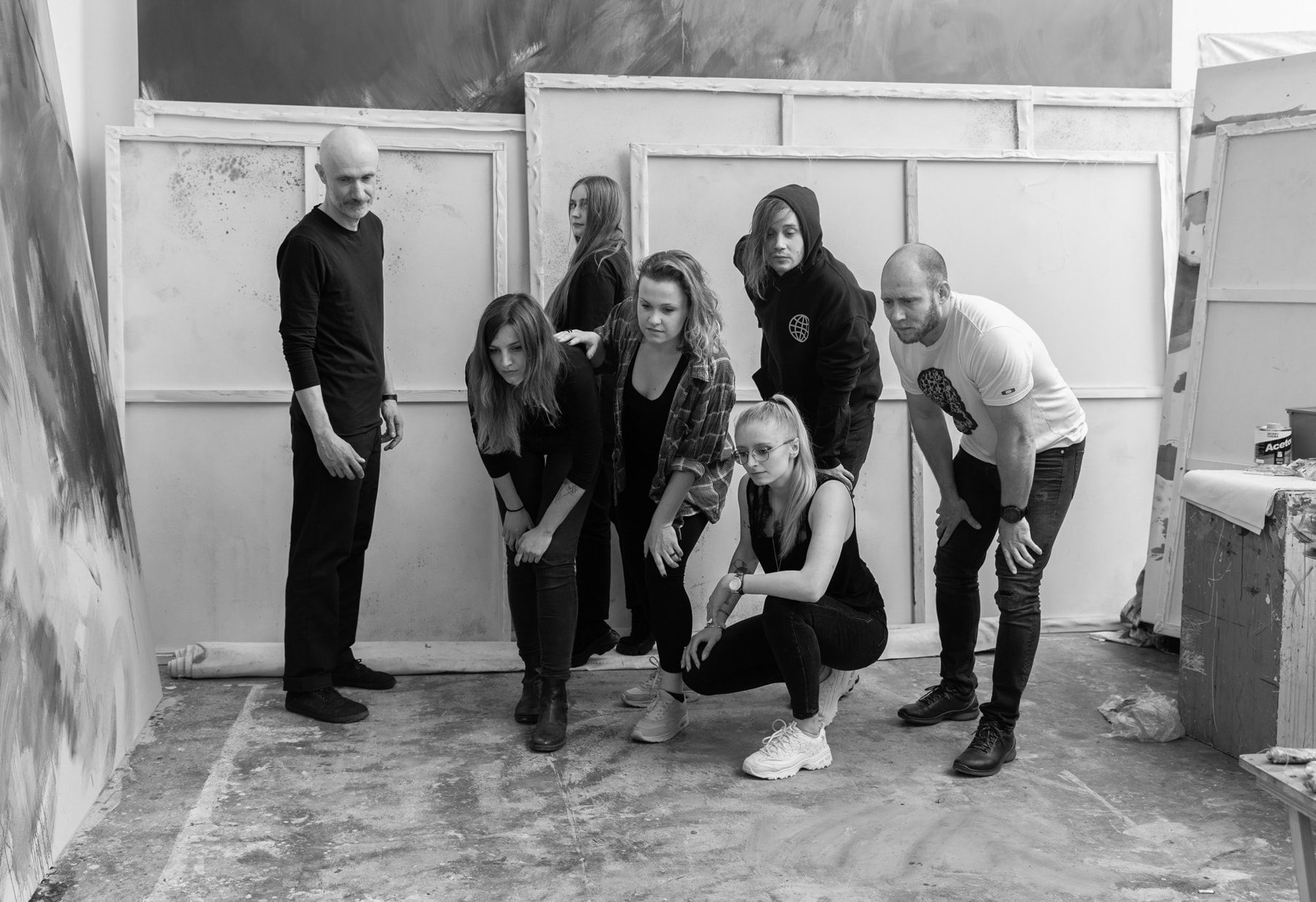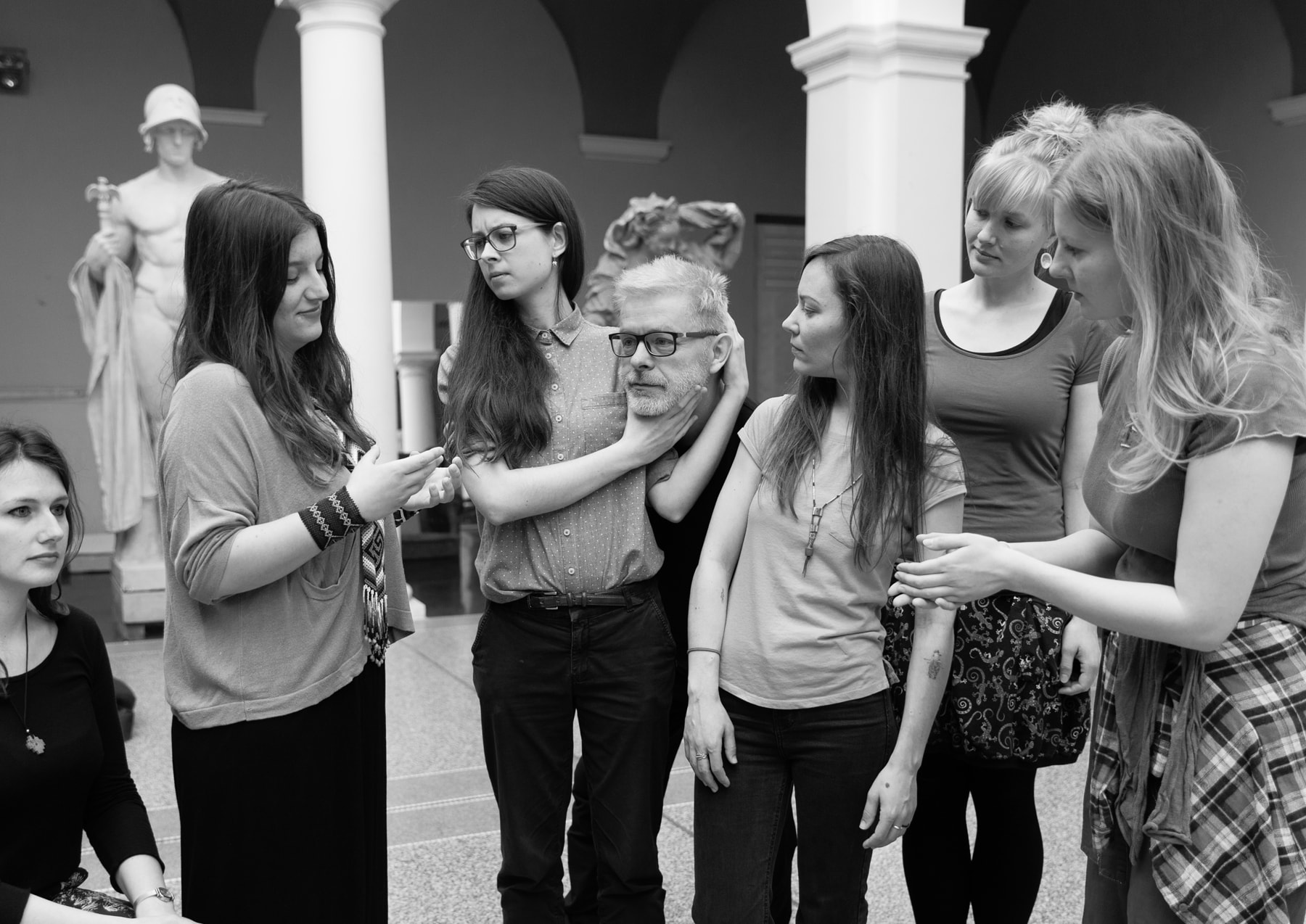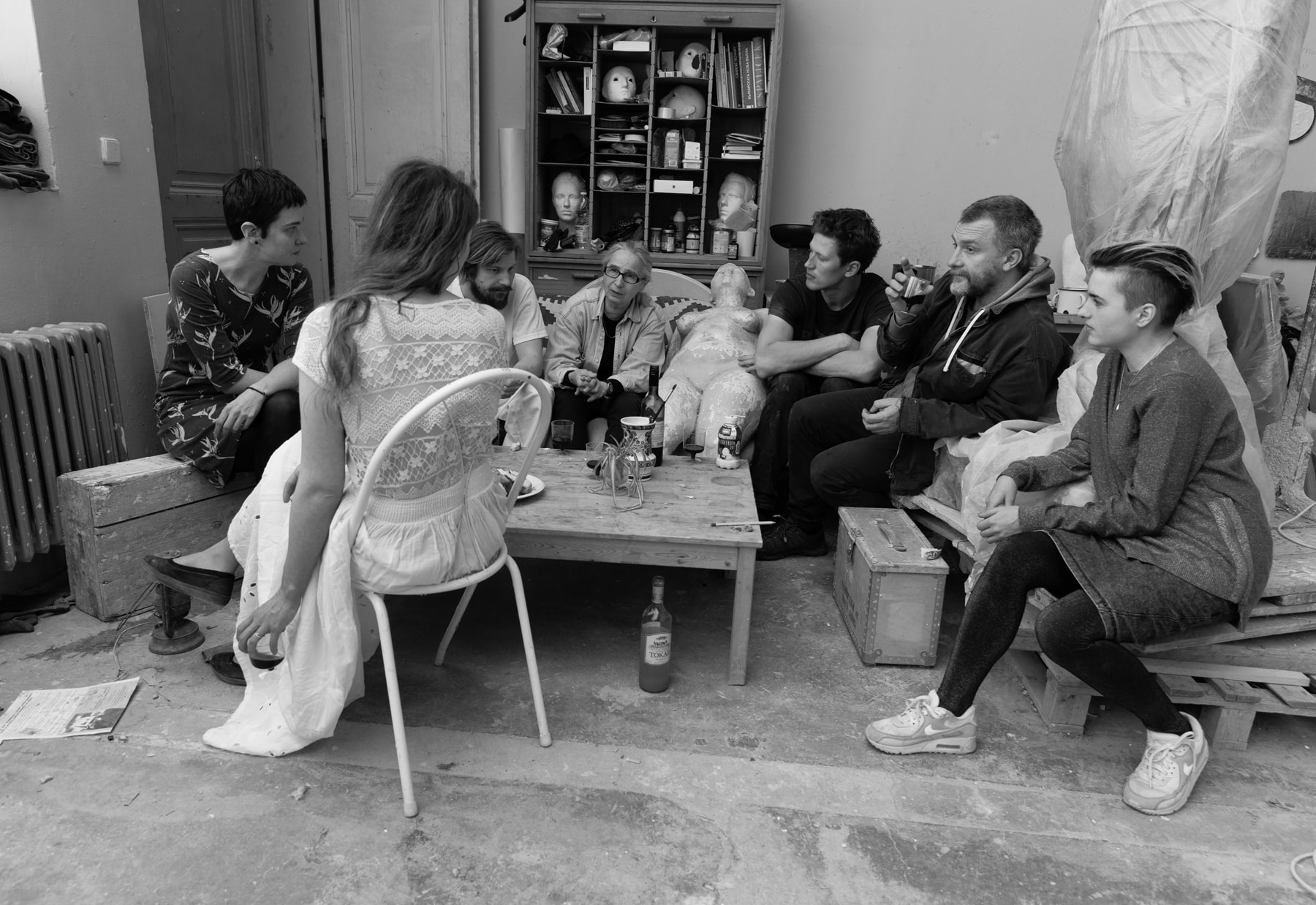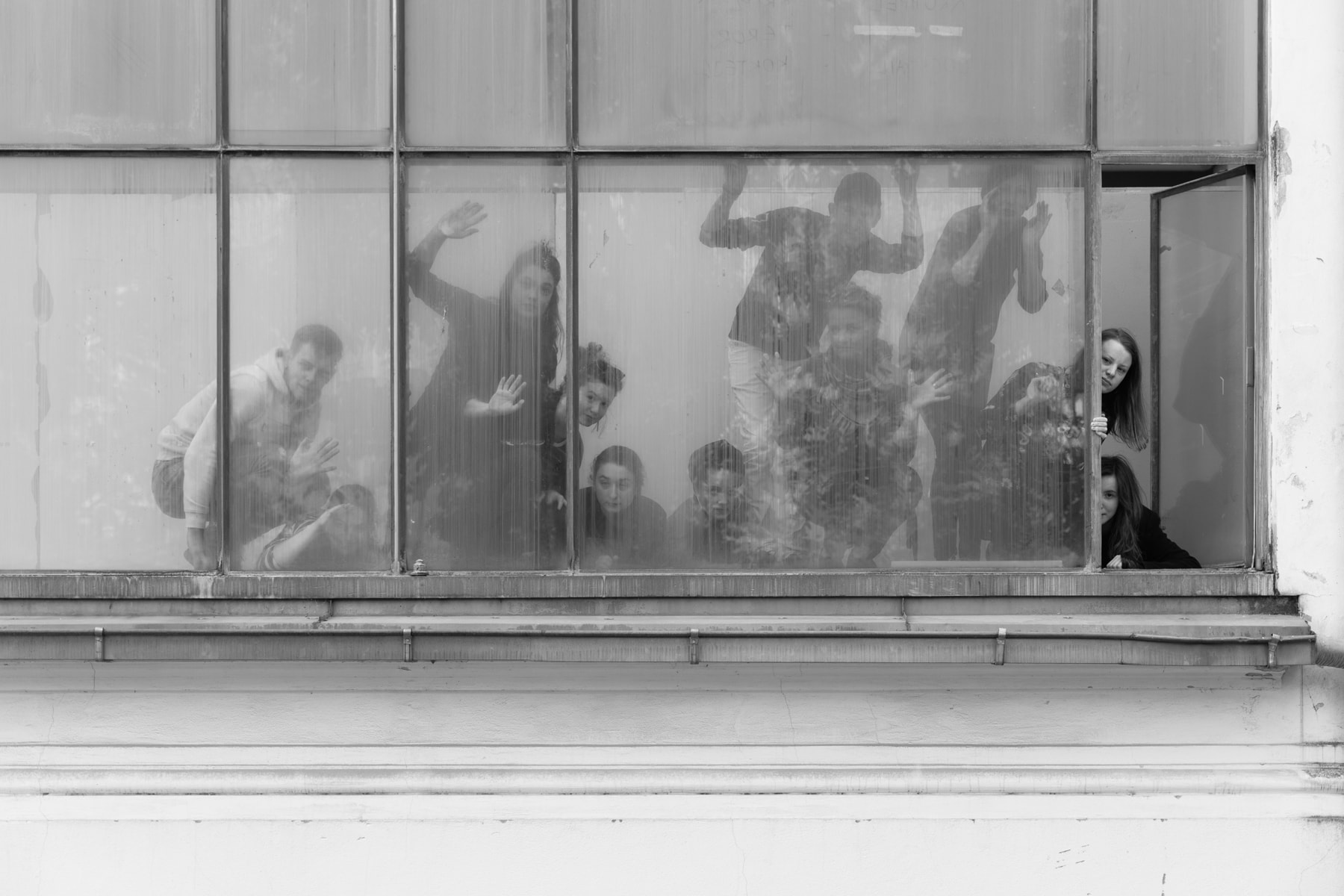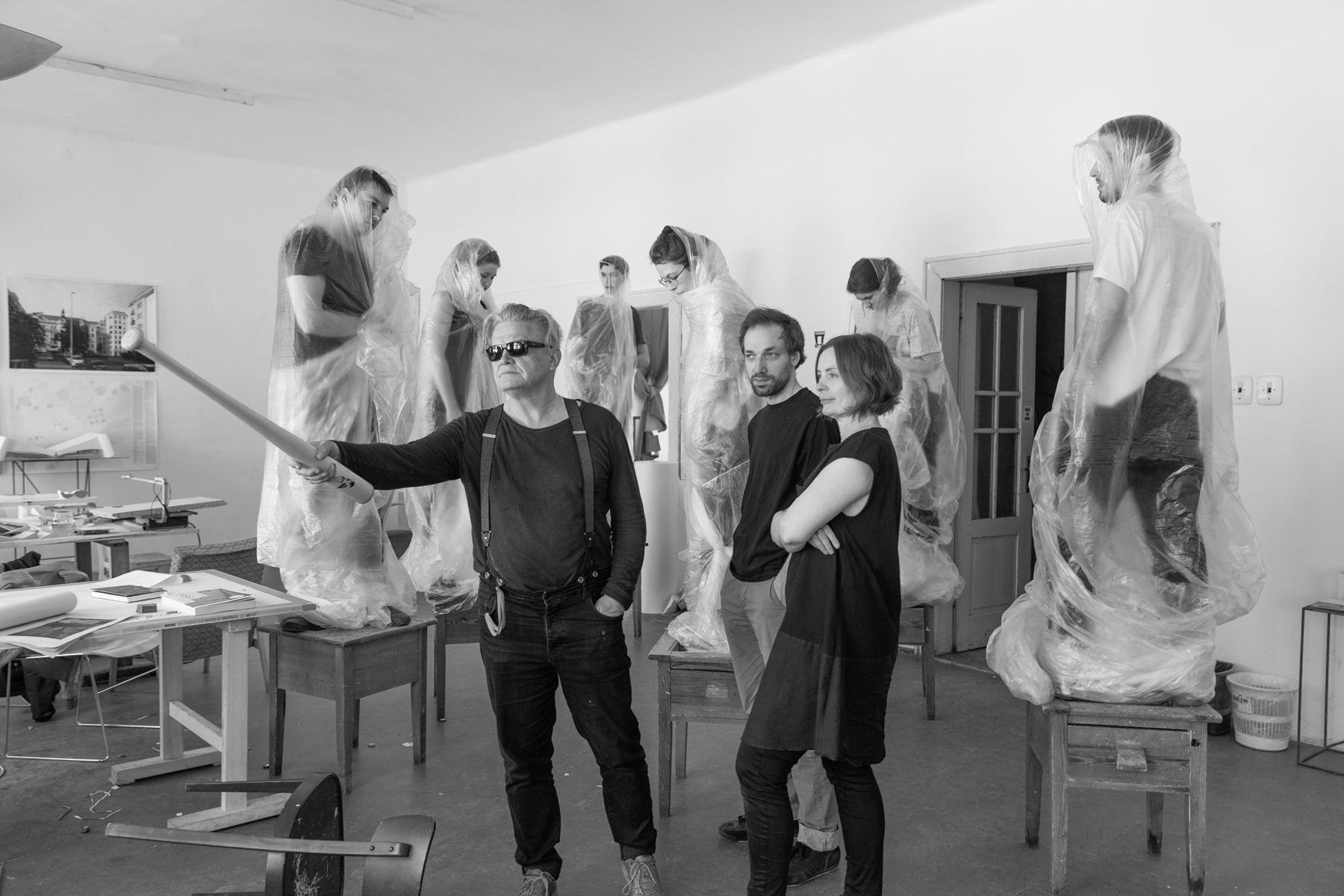How do you see your studio five years from now?
2019 • Graduates AVUPainting I
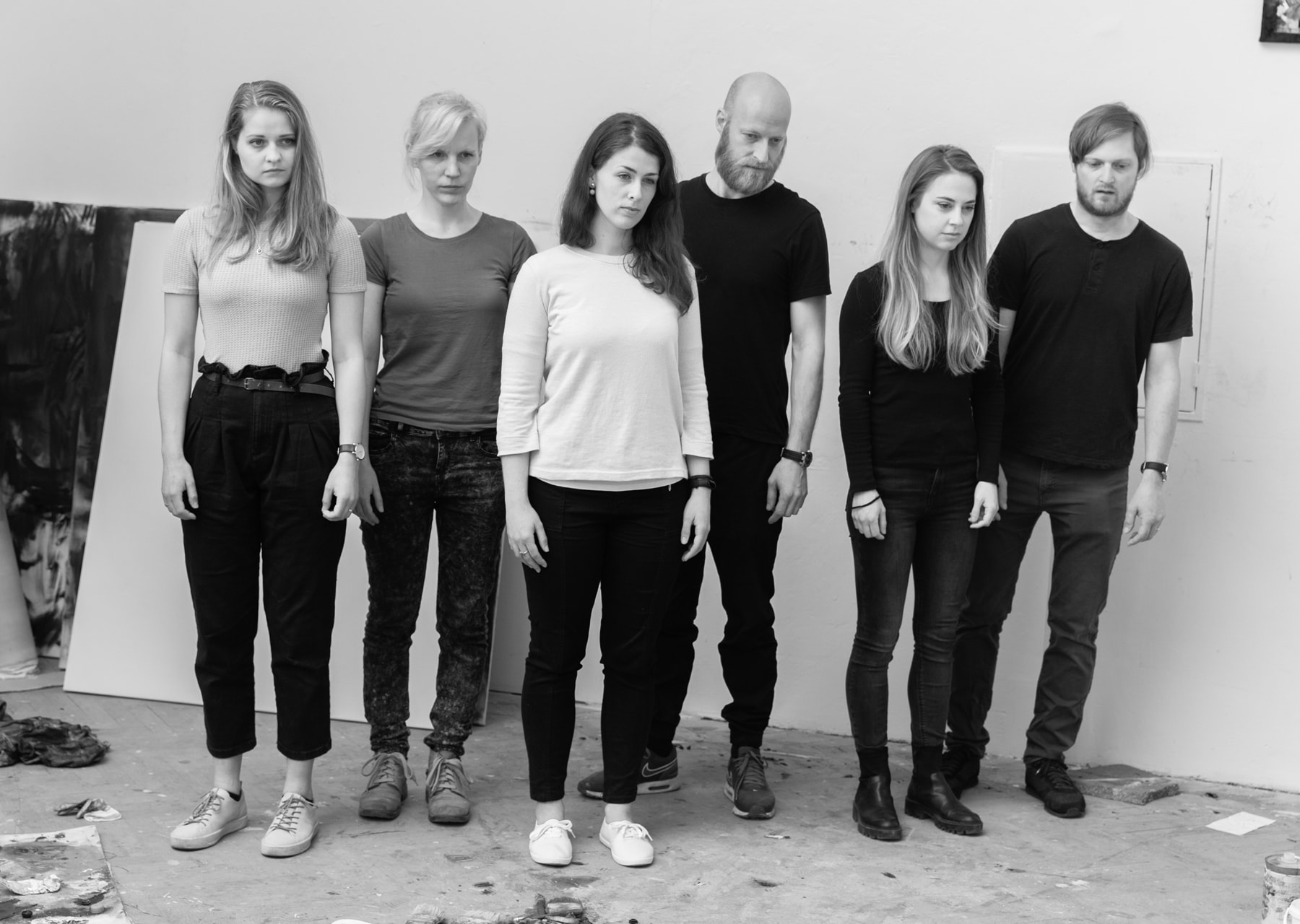
As a studio, we yearn for a more fluid, happier, and on the whole more balanced life, and so we emphasize the present. That is our foundation. We do not look back at what was, nor do we fantasize about our future. We are not controlled by our successes, disappointments, or traumas. Our sense of satisfaction is not dependent on happy memories from the past, and we dream of the joys that await us in the future. We are not limited by a fear of things that will probably never happen anyway. We are absolutely absorbed by painting. We don’t even notice that a car is honking its horn across the street, or that the person at the neighboring easel is rustling with their brush. What if we run out of paint tomorrow? What if the canvas isn’t properly stretched? What if our teachers die? Absolutely nothing troubles us. We live in the here and now.
Painting II
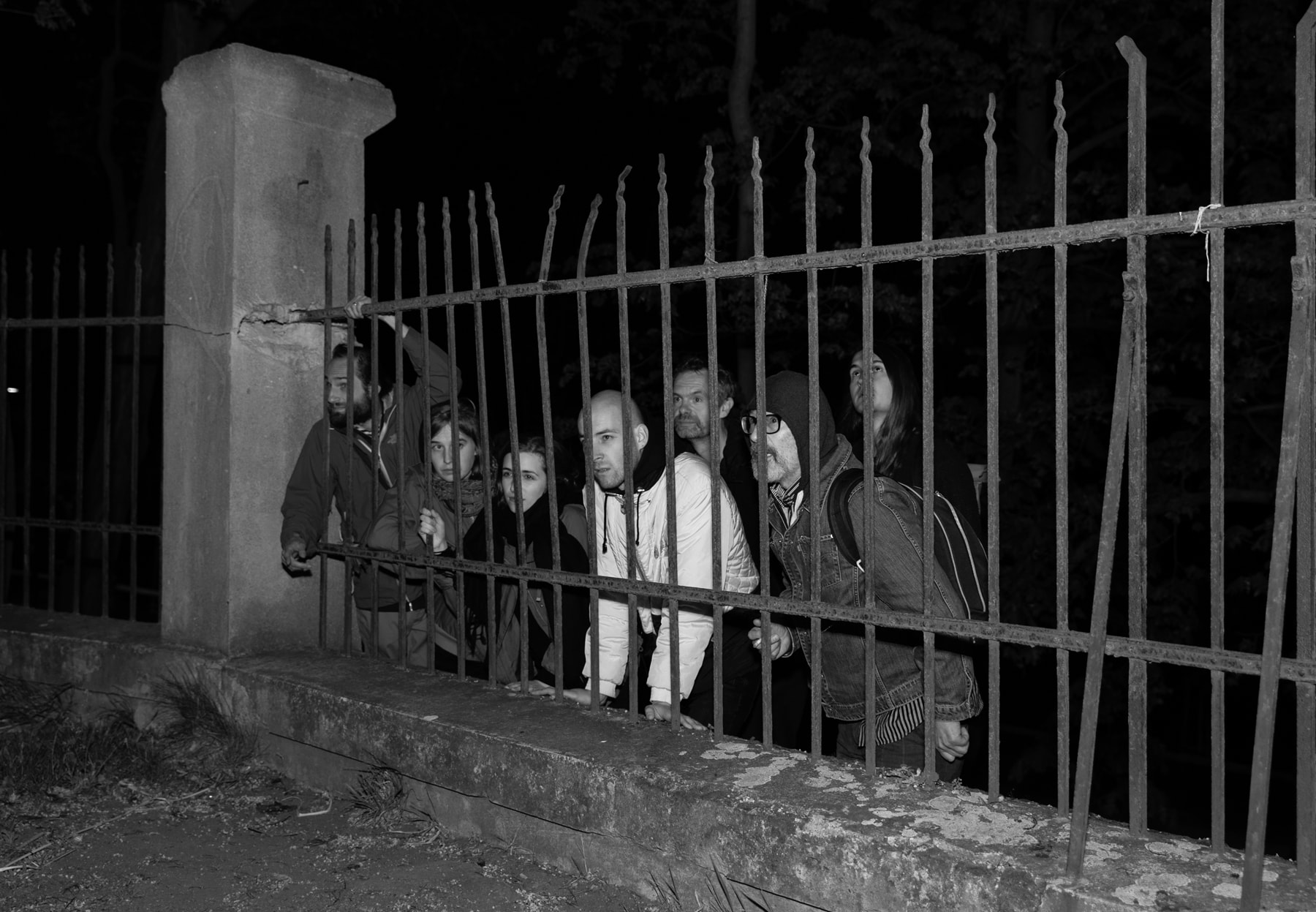
We don’t know what will be tomorrow, we don’t know what will be the day after tomorrow, we don’t know what will be the day after the day after tomorrow, we don’t know what will be the day after the day after the day after tomorrow, we don’t know what will be the day after the day after the day after tomorrow, we don’t know what will be the day after the day after the day after the day after the day after tomorrow, we don’t know what will be the day after the day after the day after the day after the day after the day after tomorrow,
we don’t know what will be the day after the day after the day after the day after the day after the day after the day after tomorrow,
we don’t know what will be the day after the day after the day after the day after the day after the day after the day after the day after tomorrow,
we don’t know what will be the day after the day after the day after the day after the day after the day after the day after the day after the day after tomorrow,
we don’t know what will be the day after the day after the day after the day after the day after the day after the day after the day after the day after the day after tomorrow,
we don’t know what will be the day after the day after the day after the day after the day after the day after the day after the day after the day after the day after the day after tomorrow,
we don’t know what will be the day after the day after the day after the day after the day after the day after the day after the day after the day after the day after the day after the day after tomorrow,
we don’t know what will be the day after the day after the day after the day after the day after the day after the day after the day after the day after the day after the day after the day after the day after tomorrow,
we don’t know what will be the day after the day after the day after the day after the day after the day after the day after the day after the day after the day after the day after the day after the day after the day after tomorrow,
we don’t know what will be the day after the day after the day after the day after the day after the day after the day after the day after the day after the day after the day after the day after the day after the day after the day after tomorrow,
we don’t know what will be the day after the day after the day after the day after the day after the day after the day after the day after the day after the day after the day after the day after the day after the day after the day after the day after tomorrow. Etc.
Painting III
His eyeballs were the only part of his anatomy that seemed to move freely. The growing, breaking, re-growing nails on his hands and feet and the ever-longer beard reminded him that he should inject another nutrient shot into his vein. His skin itched intolerably. As he realized the increasing immobility of his arms he felt panic and while there was still time he pushed the continuous-flow button on the supplementary nutrients. Despite the food, enough to keep him alive in the cold of space, he could no longer move his hands and fingers. And still, it seemed only minutes since he had left the ship…
The building around him remained unchanged. He rolled his eyes to try to see where he was, when he was.
I’m still alive, he thought. Nobody else ever got out of Anachron. That’s something. Nobody else ever stepped out of time to be seen again.
Deceleration continued. The bright light remained intence and he found he could see a little better. In front of him was a sort of picture, high and large. What was it? Panels, a series of panels, paintings from some remote past.
He peered harder and recognized that the panel at the top left was himself… There he was: shimmering space suit, marble armrests, pedestal below him. But they had given him wings like the wings of angels of the Old Strong Religion.
Great white wings. And they had put a halo around his head. The next panel showed him as he felt: suit shimmering but his face old and tired.
The panels on the lower level were equally curious. The first showed a bed of grass or moss with luminescence glowing above it. The second showed a skeleton standing in a frame.
His tired mind sought to make sense of the panels.
People became plainer in the blur around him. Sometimes he could almost see individuals. The colors of the paintings brightened, brightened, until they flashed gay and bold, then disappeared.
Disappeared completely, flatly.
Painting IV
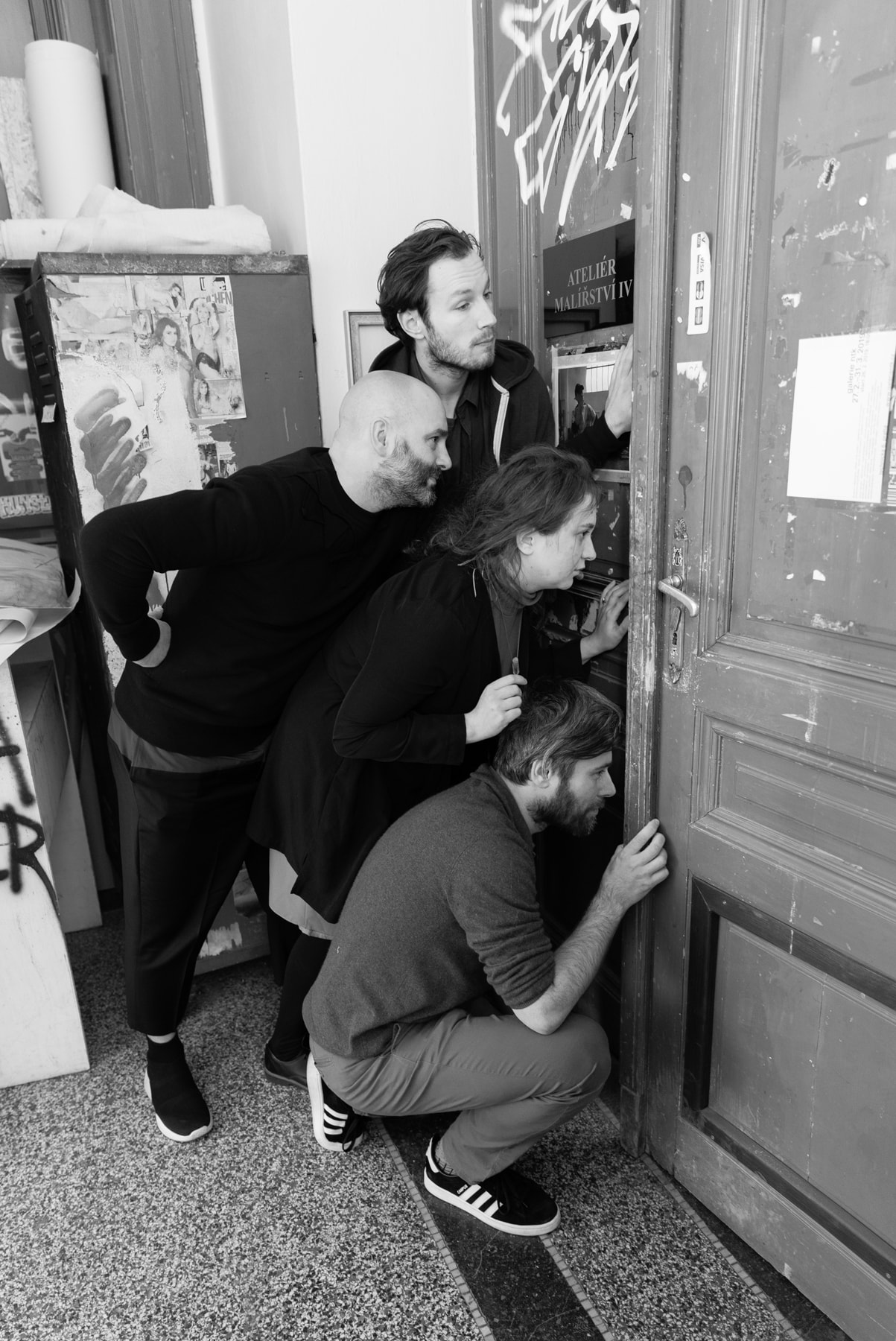
The question “Where do we see our studio in five years?” makes us think of the kind of question one might hear in a corporate job interview, which we find annoying. OOOpen space! Not that we don’t think about the future, but we try not to think of it in the sense of successes, plans met, or ratings – although in an ideal world all of this would go hand in hand with producing outstanding, daring, and inventive art. However, we don’t live in an ideal world. Cousins of the West! If, five years from now, we are teaching in Painting 4, the studio will definitely be different from today, because studios are shaped by people and they will, to a significant extent, be different than they are today. Even we will be five years older, perhaps grayer, perhaps more bitter, more congenial, more obese. A second brain! At the same time, today as well as in five years, we will attempt to find the right balance between rules and freedom, trends and consistency, knowledge and solipsism, and so and so forth. Today as well as in five years, we will be persecuted by quarrelsome dualities, excited and disappointed and excited again, transformed by time and our own free will, and petrified by institutions like the Academy of Fine Arts. Manichaeism! To summarize what was said above: We believe than in five years all our graduates and current students will be an integral part of the world of art. Anyone who claims otherwise is lying and shouldn’t be believed. After all, in the world of art, everybody lies. All the participants in all job interviews lie. Including the world of corporations and of curators. La-di-dah!
Drawing
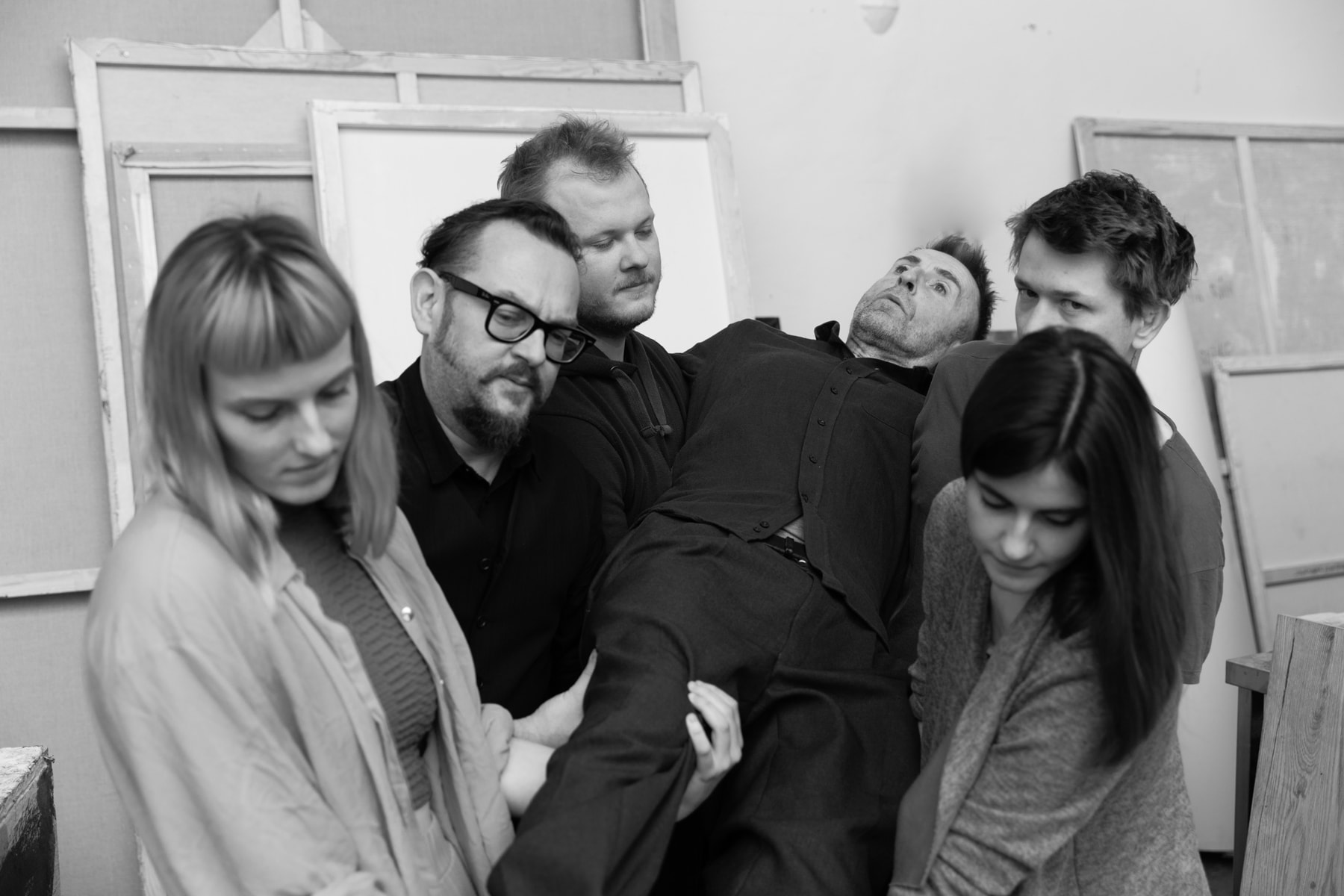
I consciously don’t try to shape any future vision for the studio. After years of experience teaching at AVU, I have learned that planning and coming up with my own visions of the studio – a creative environment where change is a natural, everyday thing – is naïve and a waste of time. A teacher’s task is to properly choose the kinds of people who are likely to develop personally and to progress in their creativity, inspired and enlightened by their current situation. I consider myself a “Taoist” teacher who works with and helps to shape the impulses and changes that, every year and every day, the students themselves bring to the studio.
Printmaking I
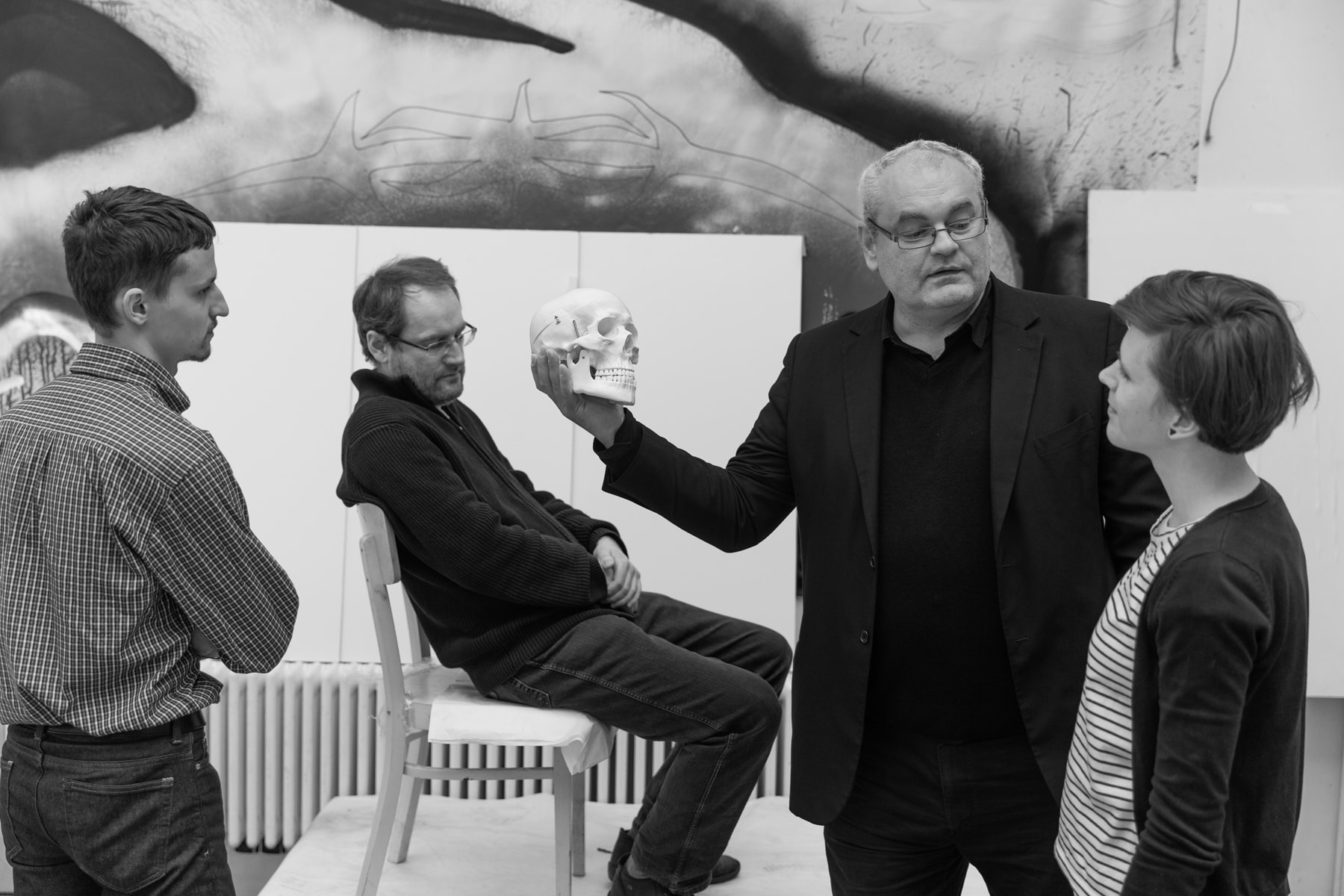
The aim of the Printmaking Studio I is to provide a foundation for students with specific talents in the fields of drawing and the graphic arts. Their talents differ depending on which of two types of personality they are. The first consists what can be called exclusively graphic individuals who, by their often introverted approach and capacity for inner vision, work on the scale of traditional printmaking techniques, which they eventually master perfectly. The presence of this kind of person in the studio may raise questions as to the meaningfulness of their studies – they come, they leave. They are quite legible as individuals, they seek out and find the content of their works through the gradual construction of their own visions. They have patience, are thorough and proud in what they do, and have a self-contained confidence that has no time for doubts – or at least they don’t talk about them. They represent the certainty of a particular type of tradition and crafts. They believe in their vision and in its realization using the physical process of building the graphic image.
The second type of talent is the conceptual student. These individuals consider the broader contexts and principles of graphic expression. They have no need to realize everything using traditional printmaking techniques, and they enjoy personal experimentation. The printmaking studio offers them the chance to explore and find their own approaches. They test their approach to drawing and printmaking by forging their own form and content. The result of their endeavors need not be a traditional printed image. Their exploration has multiple variants and paths towards achieving a final outcome. The main focus or content of their work may be visible in the course of their journey, somewhere in the middle, on multiple levels of understanding. In terms of materials and drawing, they think in terms of a wide range of forms: realistic depictions of the world, transformations of reality, non-figurative works, object and installation art, and non-traditional materials. Although they make do without traditional techniques, they nevertheless see and think in terms of graphic art.
I would like to use these two archetypes of students to outline a basic definition of what I understand under the term “graphic art,” with a view to the type of talent and resulting definition of teacher-student dialogue. The study program includes not just the mastery of basic drawing techniques and printmaking technologies, but also involves an individual element. The two are complementary. The main criteria are the student’s own approach, the intensity of their interest in their studies, the discovery of their own abilities, ways of visual thinking while also considering broader interdisciplinary contexts, the intensity of their interest in the image, and the importance and quality of form. They can work with various references or take various approaches, all depending on whether theirs is an introverted microcosm of their own visions or an extroverted, difficult-to-grasp world of infinite visual simulations in which traditional forms are replaced by a different kind of visual thinking.
The printmaking studio should be a living organism, an open community of unique individuals. The important thing is to confront different ideas and disciplines. Talent is a basic currency. The students’ personal growth takes place on an individual scale. The teacher’s job is to create the proper conditions for students to develop their talents and to promote the unique traits they bring to the studio.
Graduates should be educated in their field, but familiar with a broader range of artistic contexts, equipped with a well-defined position within a broad spectrum of visual creations. They should be able to define their personal view of the world through masterful artistic expressions free of theatrical technological finesse or formal aesthetic banalities. They should have faith that authentic expression goes hand in hand with knowledge acquired through personal experience and is not necessarily related to topicality or attractiveness.
Printmaking II
In five years, nobody will remember which studio was ours because they will all be named after scents. One of the studios, I believe, that will truly stink will be Forest Scents, i.e., today’s Printmaking II. It will stink because it does not do pure art. Instead, it works with things that look like trash, that have lost their name, that seethe and sully. It has a strange sense for how one thing is imprinted on another, how images can continue through various other things. The studio’s memory is filled with a pile of seen images, viewed within the space of the image. This is another of Forest Scents’ specialties: It believes in images as more than just bearers of verbal messages. It is only by coincidence that the studio produces “contemporary art.” After all, “the contemporary” originates from five years in the past.
Sculpture I

Less as a place of precipitous changes, and more as a temple of concentration and search for one’s own form of expression. Absorbing the present and learning the fundamentals of working with the materials and ideas that worked for our predecessors are useful skills for the path to one’s future. I see a sculptural Baikonur, a launchpad from which to set out on the journey to one’s planets, shining for the greatest possible number of like-minded people.
Sculpture II
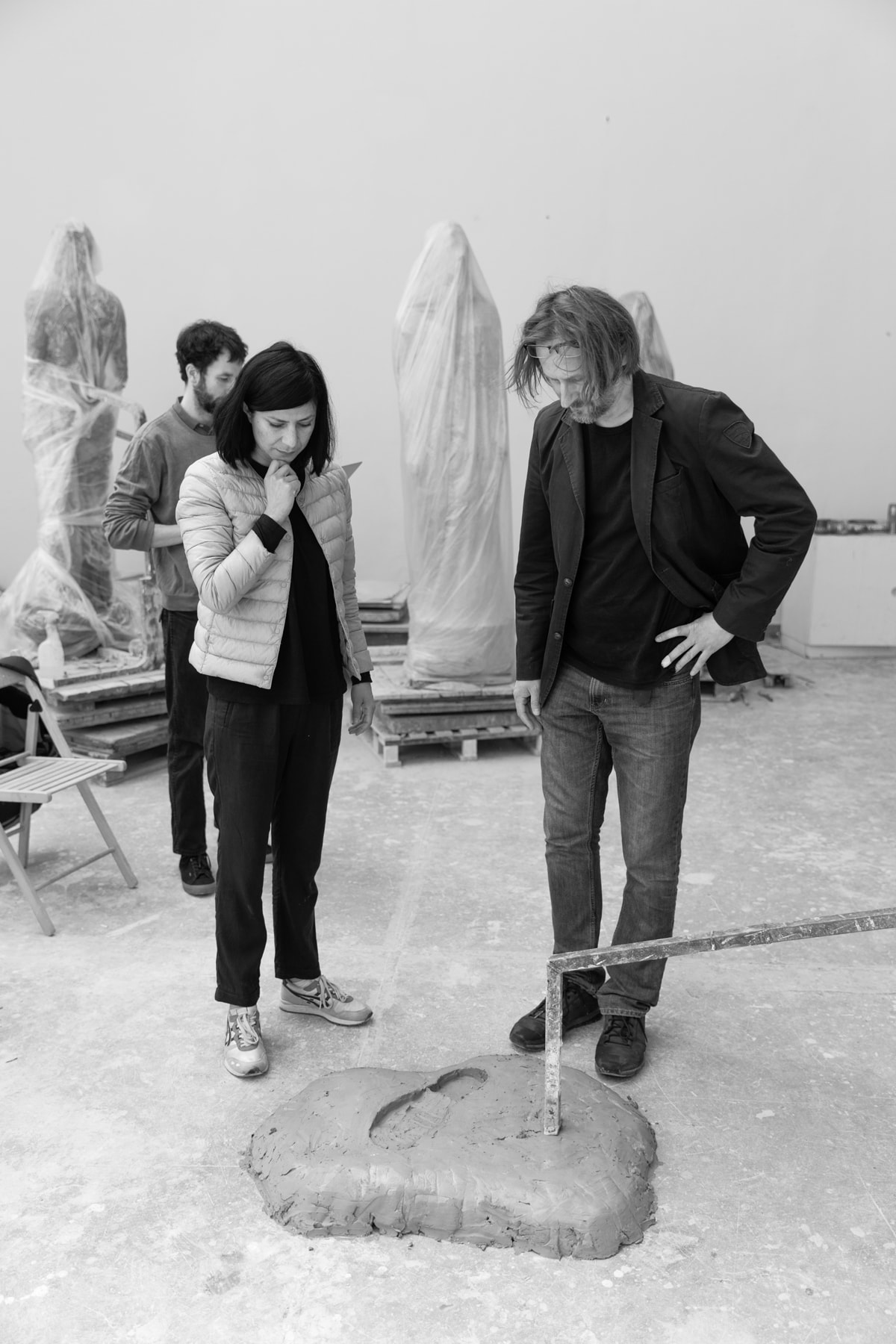
Sculpture Studio 2 is a kind of living organism, joined every year by two to three new students whose future development, both personal and in terms of talent, cannot be entirely predicted in advance. Similarly, our approach to teaching is in no way dogmatically defined but evolves over time along with our personal approach to art and is no less significantly influenced by our students’ current focus and changing interests.
One might nevertheless say that our long-term goal is not just for the studio to focus on formal and technical skills, but above all to cultivate our students intellectually. We consider the search for ways of thinking and talking about art to be a central part of instruction in the sculpture studio.
We would like the studio to retain the broadest possible spectrum of opinions and formal approaches to art. We will work to create an environment that is pleasant but that also provokes us in some way. In terms of its spaces and facilities, the studio is focused primarily on spatial work with material—sculptures, objects, and installations—but we also welcome approaches that cross over into other media (drawing, painting, photography, video, performance, sound, digital technologies…). We consider the studio’s multidisciplinary focus to be very important, one example being our collaboration with AVU’s Studio of Architecture.
In the future, we would like to introduce a master’s program for foreign students, which has already been accredited. We will also focus more on collaborating with foreign art schools, and we are planning to further expand our Ph.D. program and to promote collaboration between Ph.D. students and master’s students.
Figural Sculpture and Medal
A quiz question and a prophecy. I don’t know… perhaps we should instead focus on the here and now. We don’t want to meet any plans – we are working with the people at the school today, who can’t wait five years for us to fulfill some basic conditions for development that we have undertaken to implement. I also don’t know why five years. I hope we’re not working in a five-year planning cycle. Sure, I can write that our studio will be fundamentally better equipped and that we will change the way we teach with an aim for greater productivity… perhaps. But if anything, the question should be aimed at the school as a whole. Where are we headed? I’ll apply the question to myself: I can maintain my basic standards of instruction and the way of seeing the world that I brought with me, and I can, for instance, think about how to change my approach on the basis of prior experience… and by extension, influence the school’s future, meaning the Academy as a whole. And the studio? It depends on how the people at the studio interact with one another. Both teachers and students. It depends on each individual and his or her desire and self-confidence to create something, to do something, to find ways of expressing themselves and their topics.
Intermedia I
Markéta:
In a few years, studio no. 8 will be a maze of buxus plants with a fountain in the middle. The studio’s members will be an immaterial collective consciousness, which will greatly facilitate consultations.
Zlata:
There will be flowers, light, and love everywhere.
Eliška:
In five years, the studio will have an automatic retractable roof that can be slid into the ground along with the glass wall.
Mia:
The studio will be filled with colorful sofas covered in dust.
Bára:
In five years, the second floor will be filled with art.
Dorka:
I would like the studio to be covered in grass and flowers, because thanks to the deluge that will come after us there will finally be something to grow from.
Emílie:
In five years, the entropy in studio no. 8 will be organized.
Ondřej:
In five years there will be a metro stop underneath the school with a direct connection to Žižkov.
Markéta:
In five years, mankind will have chopped down all the forests, and in order to survive the winter at school we will have to burn the studio’s wooden floors and paneling.
Lucie:
In five years, studio no. 8 will have a greenhouse filled with plants.
Štěpán:
In five years, the studio will have: 5 first-years, 3 second-years, 8 third-years, 6 fourth-years, 1 fifth-year, and 12 sixth-year students.
Intermedia II
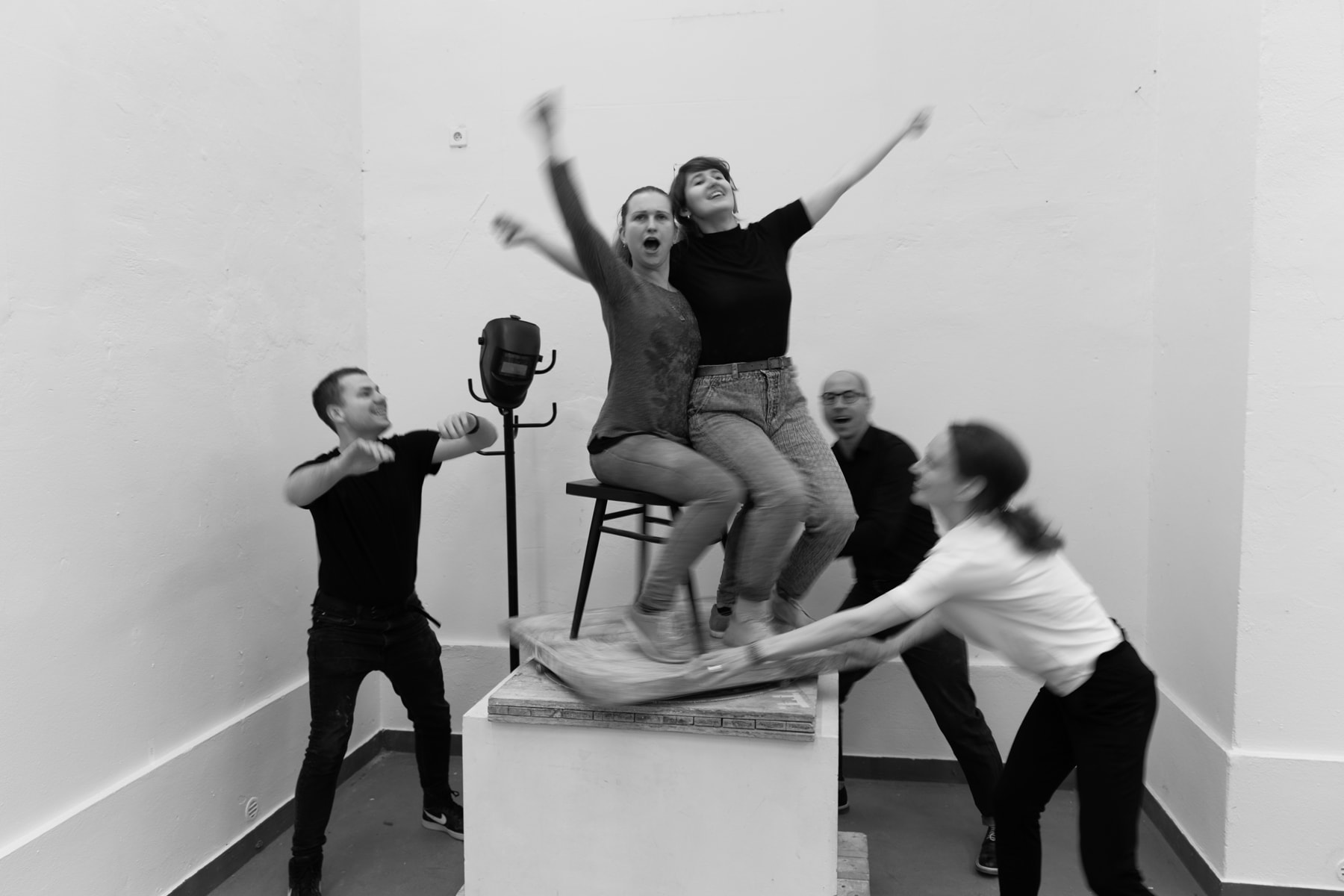
With us or without us, the Studio of Intermedia Art II should be a place where even doing ordinary things is an adventure. We cannot do real work, and do it with love, unless we ask difficult questions about whether we are living our lives meaningfully or whether we are merely coasting along on other people’s plans and interests.
- What positions and habits does it make sense to preserve, which ones should be left behind, and which must be invented?
- Does everyday work help?
- Can we make a gesture that will change the course of civilization in the positive sense of the word?
These questions can be answered in different ways. We want questions and answers to be explored, among other things, through joyful and exploratory playing. Some things we know without having to learn them, but there are methods that offer resistance, that refuse to be controlled. We would like the studio to be a basis for learning unfamiliar things—a place where you can be wrong, where you can fail. A zone where we respect one another and the process of learning.
- Can we define a long-term vision that gives our activities a common vanishing point? Or is it healthier to let things flow organically, according to their own rhythm?
Instead of a manifesto of “correct art,” we would like to offer our students support for fair and dignified “behavior.” We will continue to engage in long discussions on the impulse behind various artistic gestures, but without weakening the free will to do things without reason. We will provide advice on techniques that we have mastered, and will recommend others for those that we do not know. We will guide our students in learning skills that will be of practical use in their lives. We want to help them orient themselves in various forms of artistic self-realization. We want them to be capable of learning from other students the things they understand better than us. Empathy, mutual support, sharing, and healthy self-confidence are just as important tools as a careful hand, a perceptive eye, sensitive hearing.
- We will not yield, and will look straight at the heart of the problem.
- We do not take ourselves completely seriously.
- We soften our perception.
- We clarify our movements.
- We do not waste the strength of nature or of others – nor, if possible, our own.
- We speak openly about the things we know and the things we don’t know.
- Art is a value born out of us, but it is constituted between us.
Intermedia III
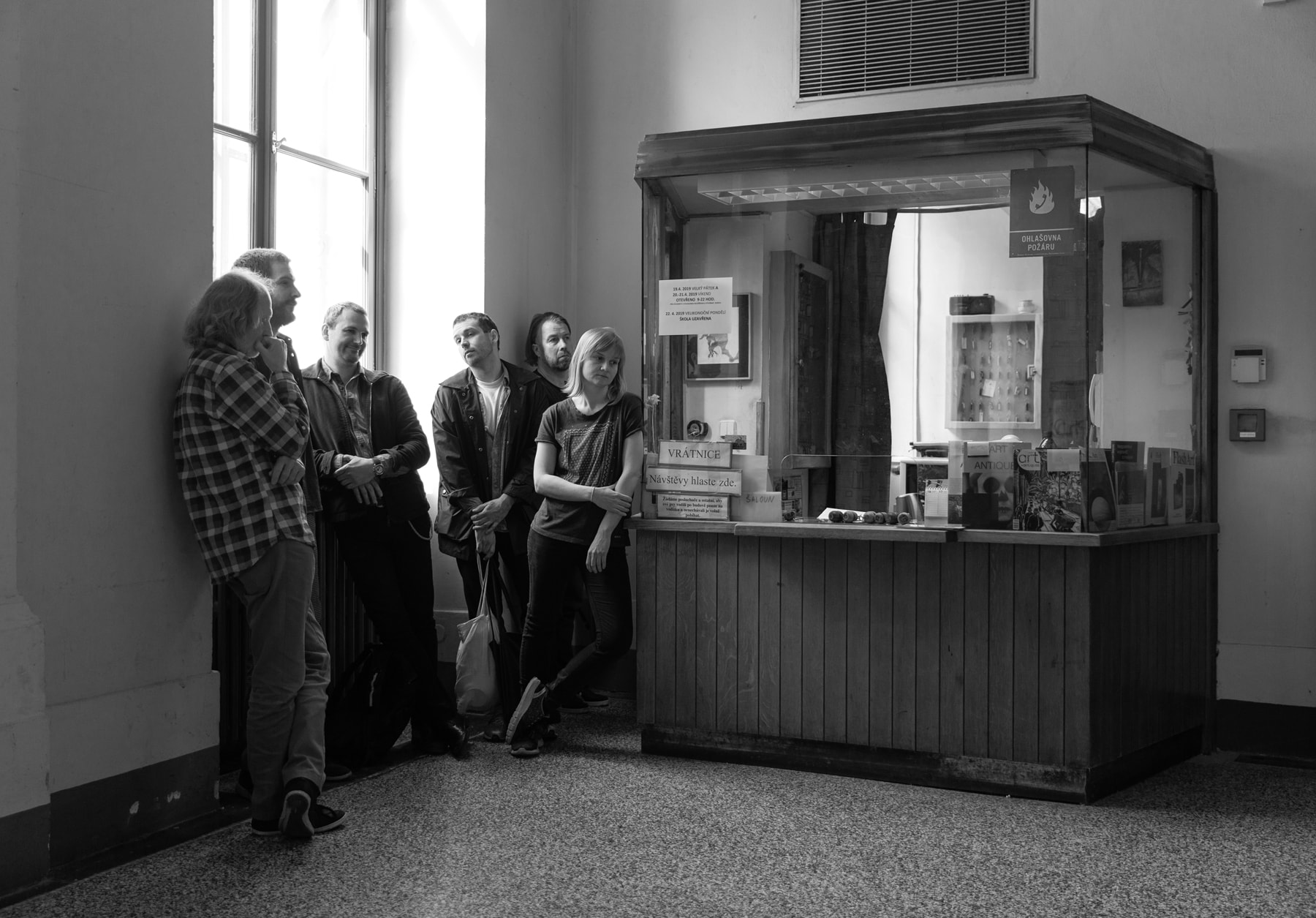
Our studio will explore the semantics of laziness as a social need and institutional hurdle, and will fulfil the concept of post-studio artistic practice. We will leave the setting of the studio, which we will return to the school so that it might be turned into a professionally equipped digital facility open to all. INTM3 will house and develop the DIGILAB. Joint meetings and consultations will be held as needed at selected places inside and outside the school. We will visit each other at home, meet in public places, at institutions, in parks and forests, or by the water’s edge. We will travel and walk and work and realize things everywhere where possible, and according to our needs. We will collaborate with laypeople and professionals, with institutions and private companies. We will present our term projects in any suitable and attractive location, including AVU. We will document our sharing of skills and knowledge, our evolving together, and our mutual influencing, and will present it all on social networks.
New Media I
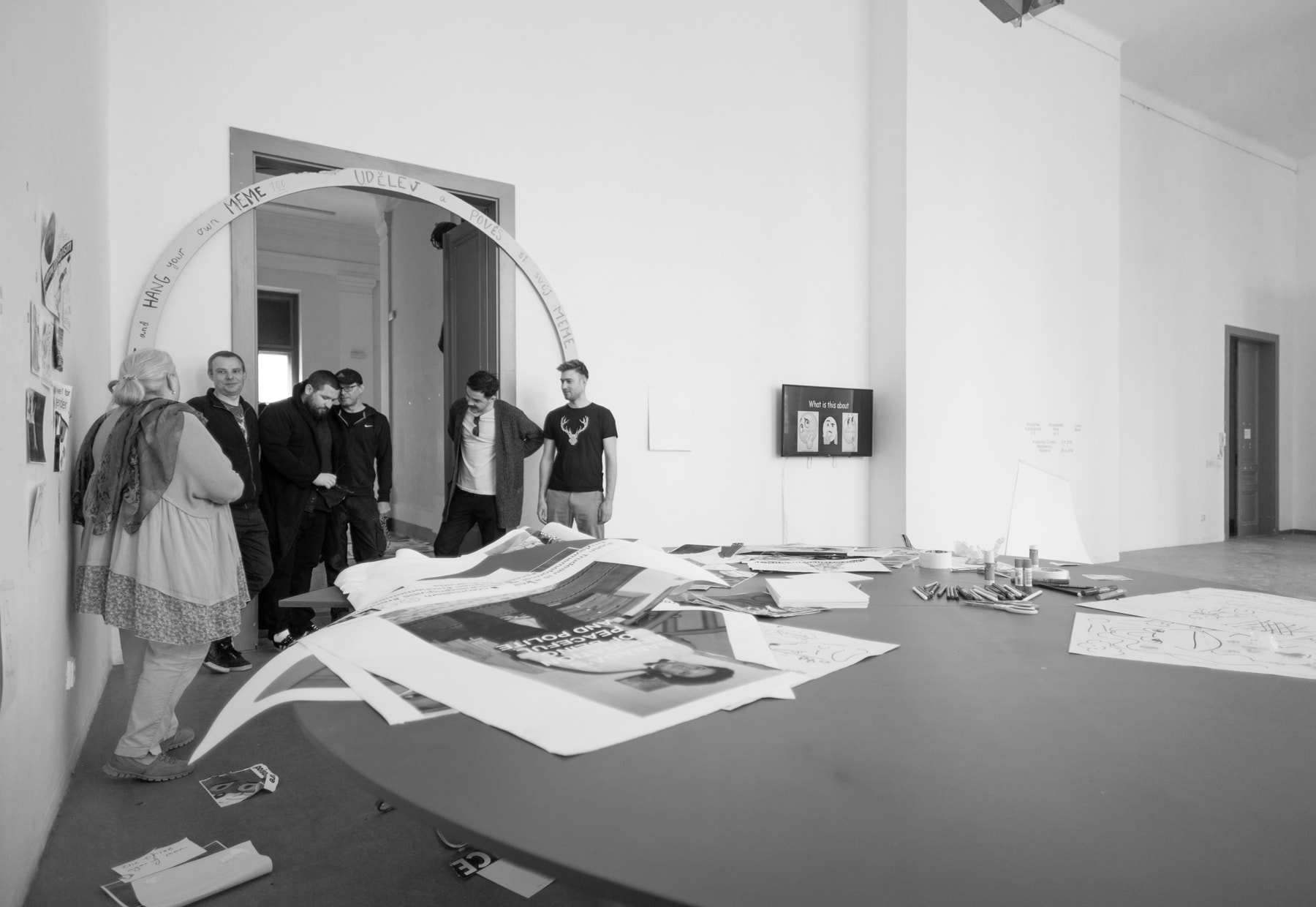
2019 – The graduating students from New Media 1 successfully complete their studies at AVU with projects that explore serious social issues while also making highly innovate use of form, thus contributing to expanding the field of visual culture.
2020 - The graduating students from New Media 1 successfully complete their studies at AVU with projects that explore serious social issues while also making highly innovate use of form, thus contributing to expanding the field of visual culture.
The Studio of New Media 1 becomes a key place for the articulation of these issues.
2021 – The graduating students from New Media 1 successfully complete their studies at AVU with projects that explore serious social issues while also making highly innovate use of form, thus contributing to expanding the field of visual culture.
The Studio of New Media 1 becomes a key place for the articulation of these issues, and is seeking the path to their resolution.
2022 – The graduating students from New Media 1 successfully complete their studies at AVU with projects that explore serious social issues while also making highly innovate use of form, thus contributing to expanding the field of visual culture.
The Studio of New Media 1 becomes a key place for the articulation of these issues, and has found a path to their resolution, which it presents to the general public.
2023 - The graduating students from New Media 1 successfully complete their studies at AVU with projects that explore serious social issues while also making highly innovate use of form, thus contributing to expanding the field of visual culture.
The Studio of New Media 1 becomes a key place for the articulation of these issues, and has found a path to their resolution, which earns it the well-deserved attention of the general public.
2024 – The graduating students from New Media 1 successfully complete their studies at AVU with projects that explore serious social issues while also making highly innovate use of form, thus contributing to expanding the field of visual culture.
Art has changed the world. For the better.
New Media II
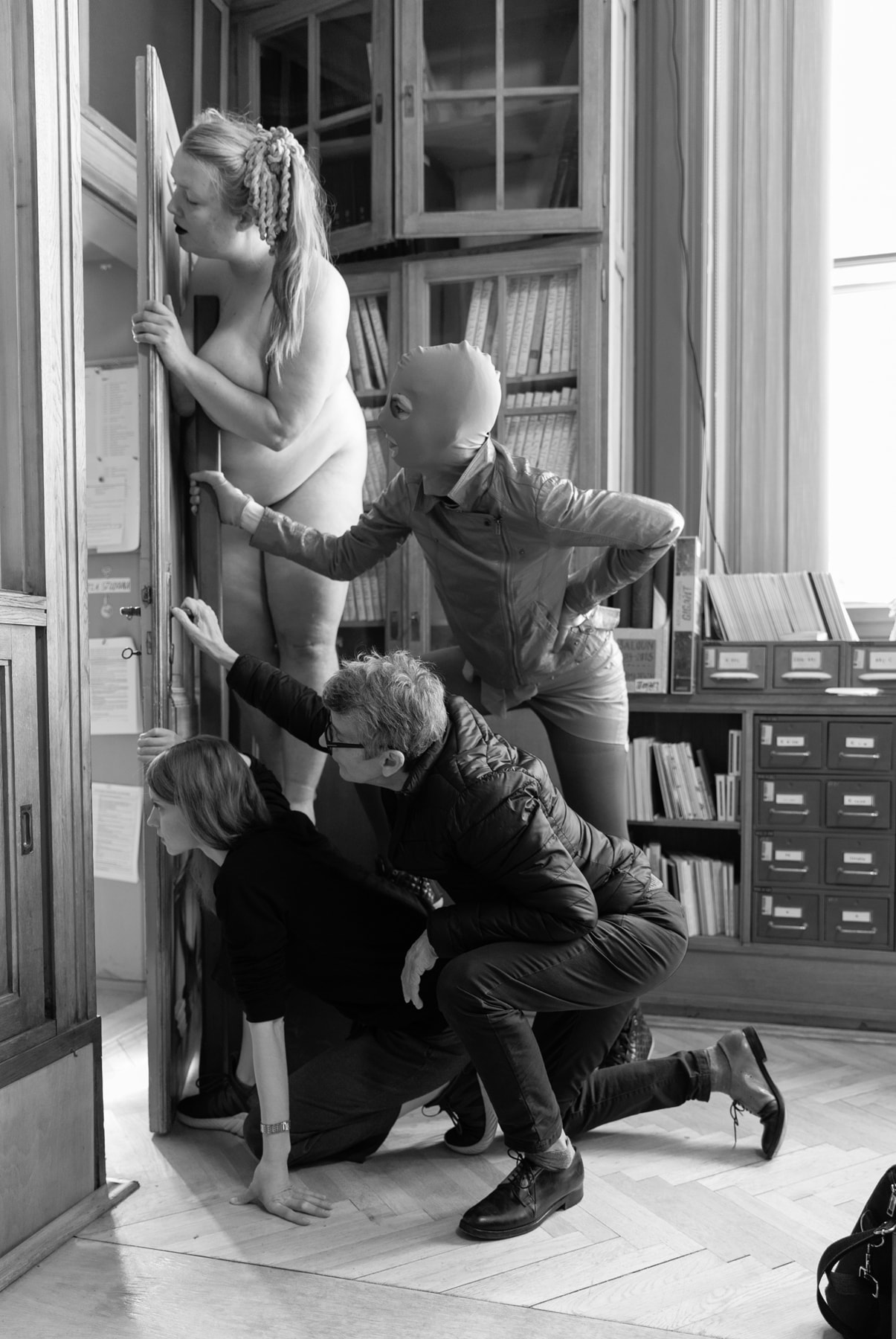
2024 – Feminist Studio of Old, New, and All Media.
We are seated with a group of female students in a circle around a fire in the school’s garden, telling stories. In the background, several dolphins jump in a swimming pool. We take turns telling stories with the dolphins, joking together. We communicate using piezo microphones placed on the bottom of the pool, a computer screen with a machine translation, and headphones. The dolphins recount ancient legends about the creation of the world. It is early evening. The sun is setting. Children play nearby, chasing each other through the garden in the orange light of the dying day. All beings are present. Besides us, the children, and the dolphins, we are aware of plants, trees, animals, the spirits of our ancestors, and other, entirely unknown, entities.
Our projects are boundless and interdisciplinary. We present them to one another through small performances. What will next year be about? We discuss the subjects and plans that will characterize our next year of collaboration. We are interested in applied art. We are used to working in teams. The studio is a collective. All relationships are non-hierarchical. There is a natural respect for the difference of others, a natural authority. We listen to one another. Some play musical instruments. We discuss the social impact of our earlier projects.
…it is not clear whether the AVU building is located on the school grounds or not…
Restoration of Painted Artworks
Art restoration is a specialised discipline with high professional and ethical demands. Besides possessing a high level of professional knowledge, an art restorer must be capable of properly reflecting on the multi-layered nature of the work of art, with all its qualities and interrelationships. In order to properly comprehend the multifaceted entirety of a work of art, the restorer must possess a professional education in the natural sciences and humanities, as well as skills as a painter. This interdisciplinary knowledge guarantees the restorer’s ability to collaborate with the other participating disciplines. An art restorer with these skills and abilities is capable of a deeper analysis of the stylistic markings of a painting and of understanding a work’s inherent painterly structure, and can determine the extent to which the original has been preserved amongst any later interventions. This is the basis for the restorer’s ability to define the material and technological methodology of the restorative work and to sensitively deal with the question of removing darkened layers of paint and secondary overpainting, or integrating missing parts of a painting. I hope that, as in the past, the Studio of Restoration of Painted Artworks will continue to fulfill these requirements, and that teaching will meet the highest demands for the care of cultural heritage.
Restoration of Sculptures
This school year, I took over the Studio of Restoration of Sculpture after many years of excellent leadership under Professor Petr Siegl. It is now more than 20 years since I first entered the school as a student, and I must say that in that time more than a few things have changed for the better, above all the facilities for professional and art restoration activities and the amount of studio space where students can work. The result is a unique school of restoration built on stable foundations growing out of many years of tradition and professional practice, with facilities that place it among leading European and international institutions. Among other things, this is thanks to the excellent collective cooperation between the school’s teachers, including assistant professors and external experts. The school has long maintained a high level of quality of instruction, and its potential is far from exhausted. In fact, it can be further developed and moved forward, among other things by collaborating with other schools of restoration in Europe.
This year, five students will present their graduation works and thus complete their studies in the restoration studio. Through their hard work, natural talent, and intelligence, they will have independently realized the restoration tasks assigned to them. They will enter a world in which they will try to find their place and build a career as professionals. Despite the significant changes in the school’s spaces and facilities, and in the face of new trends and technologies, I am more than glad to see a clear enthusiasm for learning among our current students, including all the qualities that have remained unchanged over the years despite the unstoppable development of civilization.
For me personally, the preservation of values and traditions is a highly important subject, not only in the material sense of the word but above all in terms of humanity, goodness, and kindness. I firmly believe that the students who come to study at AVU in the near future will, through their knowledge and earnest approach, move the school forwards in a natural manner, with at least the same effort and sense of responsibility as has been the case with its past graduates.
Architecture
Rich and happy.
